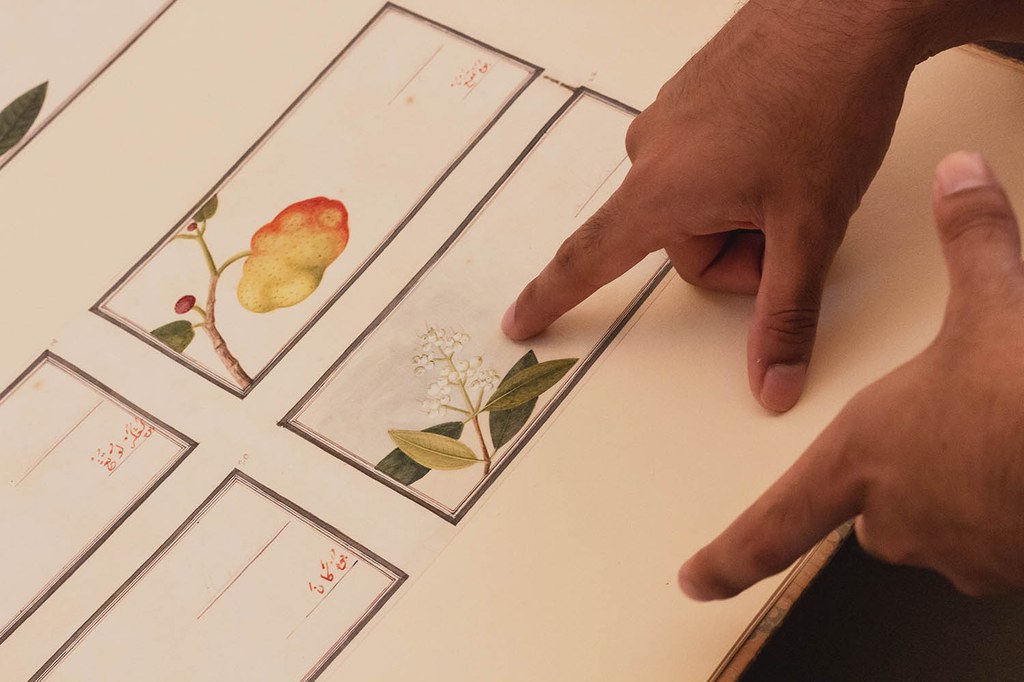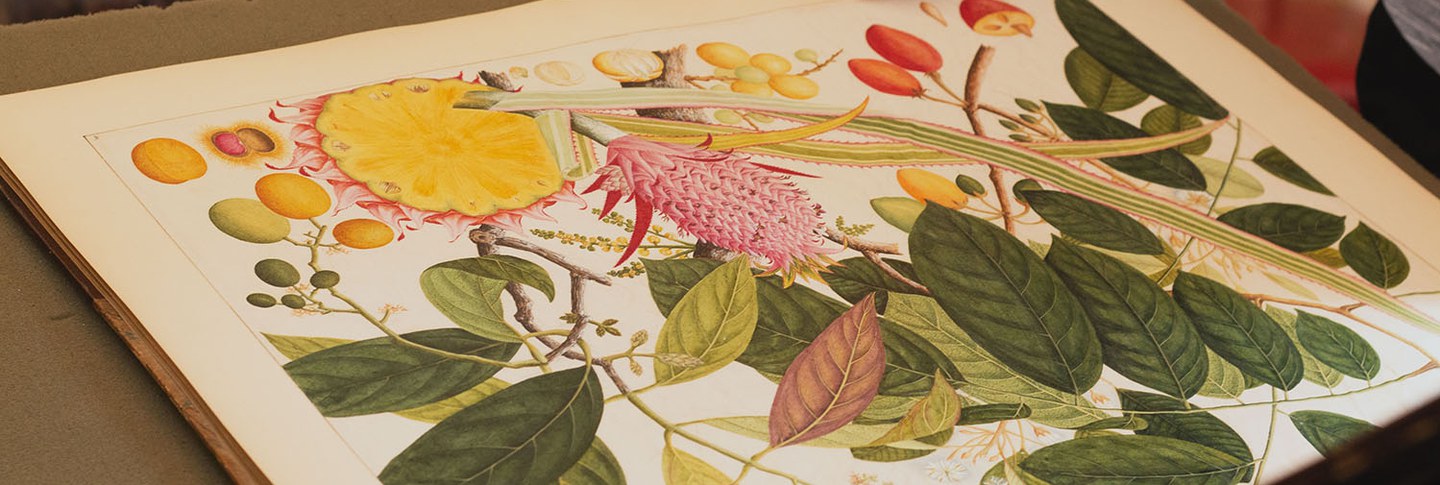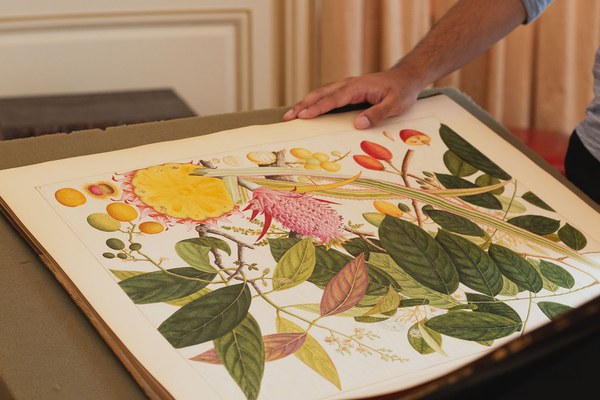By Julia Ostmann
At the turn of the 19th century, Arab merchants, European travelers, and Malay and Javanese locals intermingled with Chinese and South Asian people in the bustling port cities of the Straits of Malacca. And whether for consumption or colonial interests, almost everybody interacted with plants. Artists, naturalists, and amateurs depicted the pink pineapples, durian, watermelons, and rambutans of Southeast Asia.
For at least fifty years, this lost world hid silently in the rare book collection of Dumbarton Oaks cofounder Mildred Bliss, tucked away in a large album of detailed watercolors. There it might have remained unexplored but for a new initiative dedicated to telling stories of how plants have shaped human culture. How did scholars across disciplines and career stages collaborate to revive a forgotten cosmopolitan world—and get closer to finding the album’s artist, forgotten for centuries?

An Enigmatic Book
Wispy tendrils, ripe fruits, curling leaves, and delicate flowers fill 22 pages in the album, followed by an unusual visual index naming each plant in both Latin and non-Latin script. Cross sections of the (often edible) plants entice viewers while carefully revealing morphological features. Commercial entities like the British East India Company and Dutch East Indies Company often commissioned such illustrations of unfamiliar plants (and potential cash crops).
Mildred Bliss acquired the album sometime in the mid-20th century and believed an Indian artist had created it. But around 1958, after examining the album, art historian of British India Mildred Archer argued the art was in fact Chinese, probably done in Malaysia or Sumatra between 1798 and 1810.
What evidence suggested these dates? Who commissioned the album, painted its plates, wrote its labels? And why? For decades, no one investigated further. In a special collection focused on garden and landscape history, perhaps the botanical album seemed peripheral to researchers—a fruit dictionary next to illustrations of Chinese palace gardens and Italian villas.
Uncovering the story of the album would require a different approach. “Mildred Bliss had an exceptionally good eye for beautiful, curious, or simply interesting objects,” says Anatole Tchikine, curator of rare books. “And she never thought of the Garden Library she founded at Dumbarton Oaks as merely a collection of landscape history books. It had a place for everything that had to do with plants: botanical illustrations, herbals, seed catalogues, and even sets of timber samples.”
Looking with New Eyes
Enter the Plant Humanities Initiative, aimed at building bridges between disciplines to explore the cultural histories of plants, supported by a generous grant from the Andrew W. Mellon Foundation. The joint effort between Dumbarton Oaks and JSTOR is recruiting an intergenerational team of scholars to reinterpret hidden treasures in special collections.

Almost immediately after the Initiative launched, new puzzle pieces emerged about the album of Asian fruits. In fall 2018, a Plant Humanities advisor from the Biodiversity Heritage Library showed the album’s non-Latin inscriptions to an expert who thought they might be Urdu. Perhaps the album had a strong connection to South Asia, as Mildred Bliss believed?
A few months later, another Plant Humanities advisor was visiting Singapore’s Yale-NUS College, where he is on the governing board. He showed a picture of the album’s labels to Faris Joraimi, a student of classical Malay literature. Joraimi could read the Arabic script immediately: fruit and flower names inscribed in a dated written form of Malay, the language spoken in Singapore, the Malay Peninsula, Indonesia, and Brunei.
Thanks to a digitization effort by Dumbarton Oaks, Joraimi researched the scans from Singapore. He contacted scientists at the Singapore Botanic Garden, who for the first time identified the contemporary Southeast Asian species of all but one of the album’s plants. Focusing on plants allowed for new insights into the book’s provenance: the one misrepresented species, with leaves and fruits that do not match, suggested the artist may not have painted from life.
To Southeast Asia via Special Collections
Some questions could only be answered by examining the album itself, so the Plant Humanities Initiative brought Joraimi to Dumbarton Oaks this July. In the airy Rare Book Reading Room lined with ornate shelves, he bent over the hefty album, searching for leads.
“It’s precisely rendered. The brushwork is masterful,” he noted. “These paintings seem to blend an aesthetic sensibility with the need to document and record.”
First, Joraimi focused on the inscriptions. He determined that writing thought to be Dutch plant names was actually error-ridden transliterations of Malay into Latin characters. “You’ve got European scribes trying to reproduce the sounds,” explained Joraimi. “But who is the one providing this information, in terms of native knowledge on the local environment? The labeling gives us clues, because not many people were literate in the 18th and 19th century in the Malay Archipelago.”
Next, Joraimi compared the painting with other Chinese botanical works in the collection. Light brushstrokes and color, as well as a blue wash beneath white flowers, pointed to Chinese rather than Indian artistic style, as Mildred Archer had observed in the 1950s.
Finally, by shining light on the pages to reveal near-invisible watermarks, Joraimi was able to date the album’s paper to 1799—within the range Archer had suggested.

Plants Lead the Way
Who created the striking fruit paintings? Likely a Chinese artist living in Canton or Macao. Joraimi knows of a single piece identical in style and composition to the Dumbarton Oaks album: a watermelon drawing held at the British Library and printed in Archer’s book. But many questions remain for future research. How many works did the artist create, and where are they now? How were the paintings curated into a single album? Who were the other collaborators?
“You’ve got Chinese aesthetic sensibilities being applied to depict the fruits of Sumatra and Malaysia. The work is commissioned by European botanists. Then it uses native nomenclature to identify the plants, probably the work of a Malay scribe,” says Joraimi. He is currently writing a paper on his findings.
By letting plants lead the way, Joraimi and other Plant Humanities scholars discovered that a book once considered peripheral tells a fascinating story about human interaction across linguistic and cultural borders. The Plant Humanities team aims to build on the example of the album of Asian fruits, further demonstrating how grant-funded initiatives can invigorate special collections, spark new research, and engage the next generation of humanist scholars.
Julia Ostmann is postgraduate writing and reporting fellow at Dumbarton Oaks. Photos by Elizabeth Muñoz Huber, postgraduate digital media fellow.

